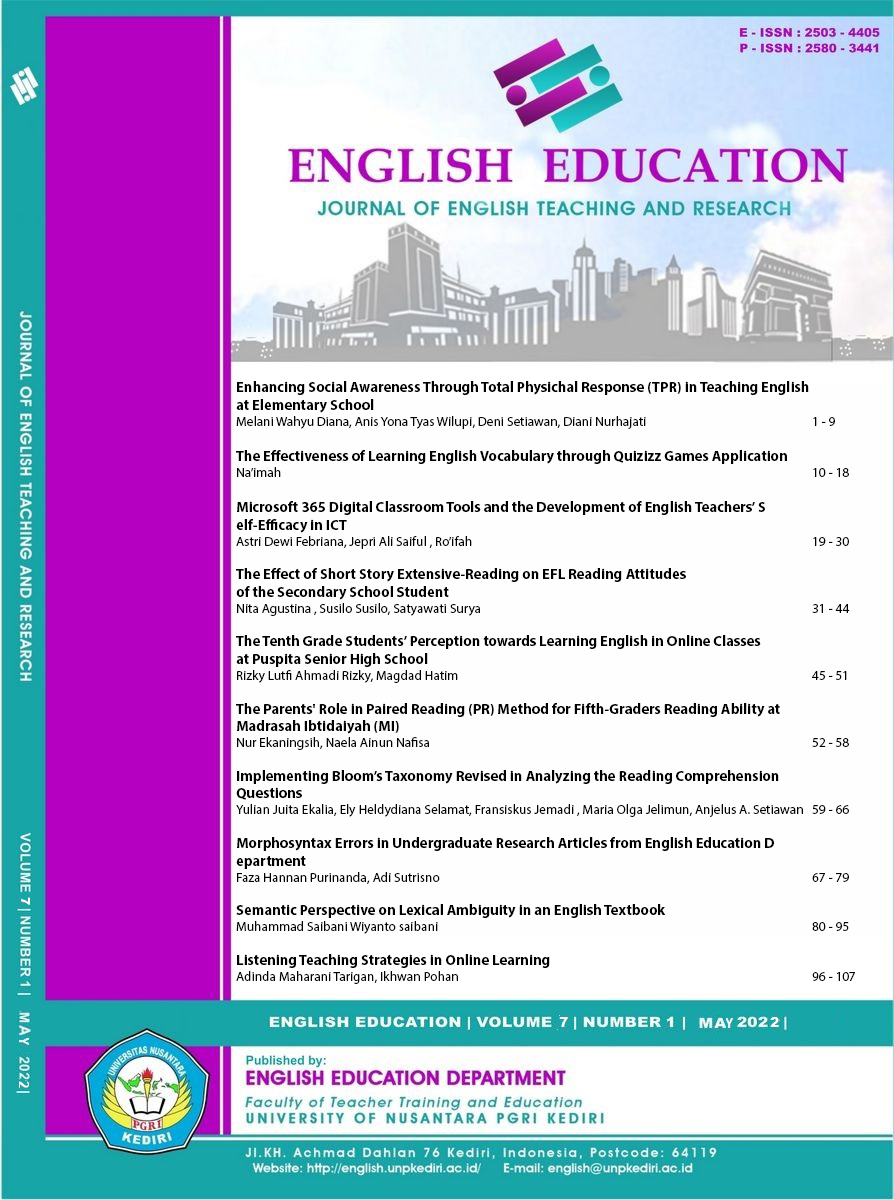Semantic Perspective on Lexical Ambiguity in English Tetxbook
DOI:
https://doi.org/10.29407/jetar.v7i1.17531Keywords:
Textbook, Semantic, Lexical AmbiguityAbstract
The goal of this study is to describe the many types of lexical ambiguity and how they are used in student English textbooks. Ullman Stephen proposed the linguistic ambiguity theory. The essay combined qualitative research with a content analysis technique. The words with lexical ambiguity are the subjects of this study. The data is made up of words, and the source is an English textbook. Reading, comprehending, and coding the text book that contains lexical ambiguity is the procedure for gathering data. The data analysis technique is then organized, familiarized, and interpreted. The findings of the study revealed that the text book contained two types of lexical ambiguity, Polisemy and Homonymy. Lexical Ambiguity can be assumed to exist in everyword with several meanings.
Keywords: semantic; lexical ambiguity; textbook
Downloads
References
Andarani & Anugerahwati. (2012). Structural ambiguity in The Jakarta Post newspaper’s headline news. Journal article: State University of Malang
Arizona, N. (2016). The lexical ambiguity in the cosmetic advertisements. Thesis of Sanata Dharma University Yogyakarta
Ary, D., Jacobs, L. C., Sorensen, C., & Razavieh, A. (2014). Introduction to Research in Education. Canada: Wadsworth.
Cresswell, J. W. (2009). Research Design: Qualitative, Quantitative, and Mixed Methods Approaches (third edition). London: Sage Publication Ltd.
Charina, Intan Nur. 2017. “Lexical And Syntactic Ambiguity in Humor”. International Journal of Humanity Studies. Vol 1 (1). e-ISSN 2597-4718. Hal: 120-131. http://ejournal.usd.ac.id/index.php/IJHS Sanata Dharma University, Yogyakarta, Indonesia
Denzin, N. K. (2009). An Introduction to Qualitative Research Fourth Edition. Thousand Oaks: SAGE.
Leech, Geoffrey. (1981). Semantics: The study of meaning. London: Penguin Books.
Litosseliti, L. (ed.) (2010). Research Methods in Linguistics. London: Continuum
Merriam Webster Dictionary [app].
Purwaningsih. D. (2014). An analysis of lexical and structural ambiguity “Rubrik Opini” in Jawa Pos. Thesis of Wijaya Putra University (7)
Puspitasari, J., Sutjiati Beratha, N. and Wandia, I., 2019. Lexical and Structural Ambiguity Found in Articles in The Jakarta Post Daily Newspaper. Humanis, p.19.
Ramadani, Nanda. 2015. “Lexical Ambiguity In The Headlines Of The Jakarta Post Newspaper”. Vivid Journal. Vol. 4 (1).http://garuda.ristekdikti.go.id/ journal/ article/359492
Tambunan. H. (2009). “The analysis of lexical and structural ambiguity in your letters of The Jakarta Post”. Thesis Medan: University of Sumatera Utara. (7)
Tirangga. B. (2014). Lexical and grammatical ambiguities of the news headline of the Jakarta Post and New York Times. Journal article of Dian Nuswantoro University Semarang. (7)
Ullmann, Stephen. (1962). Semantics: An Introduction to the Science of Meaning. London: Oxford Basil Blackwell.
Downloads
Published
Issue
Section
License
Authors who publish with this journal agree to the following terms:
- Copyright on any article is retained by the author(s).
- The author grants the journal, the right of first publication with the work simultaneously licensed under a Creative Commons Attribution License that allows others to share the work with an acknowledgment of the work’s authorship and initial publication in this journal.
- Authors are able to enter into separate, additional contractual arrangements for the non-exclusive distribution of the journal’s published version of the work (e.g., post it to an institutional repository or publish it in a book), with an acknowledgment of its initial publication in this journal.
- Authors are permitted and encouraged to post their work online (e.g., in institutional repositories or on their website) prior to and during the submission process, as it can lead to productive exchanges, as well as earlier and greater citation of published work.
- The article and any associated published material is distributed under the Creative Commons Attribution-ShareAlike 4.0 International License








 Article template
Article template



